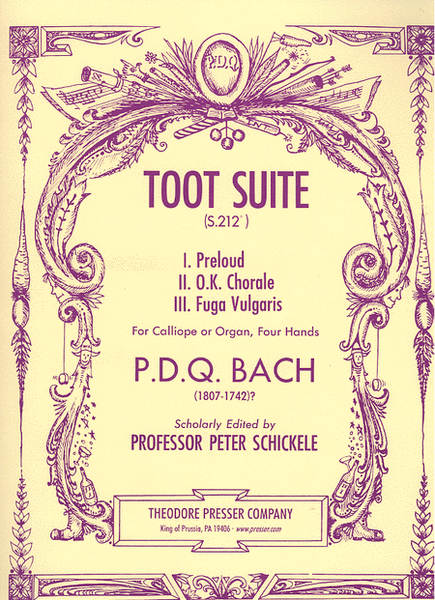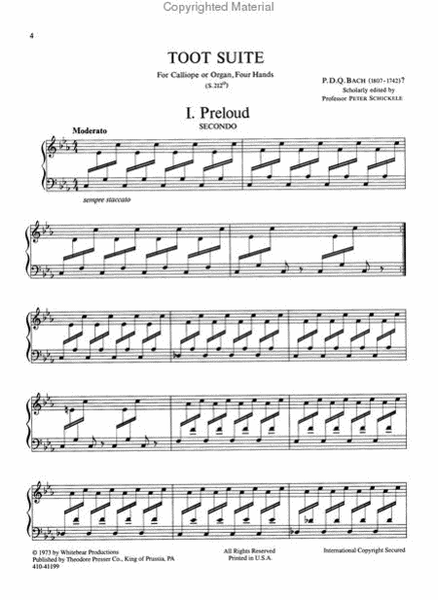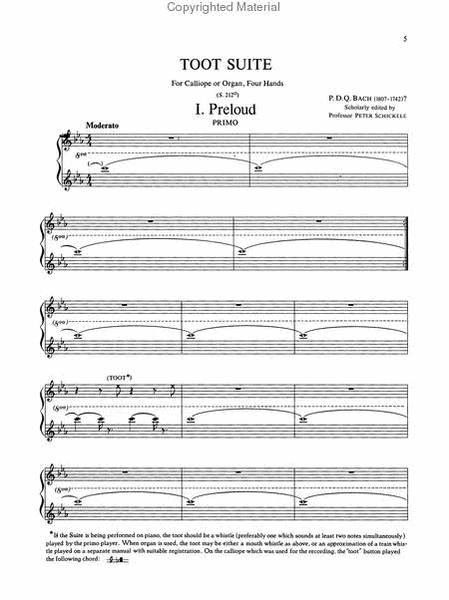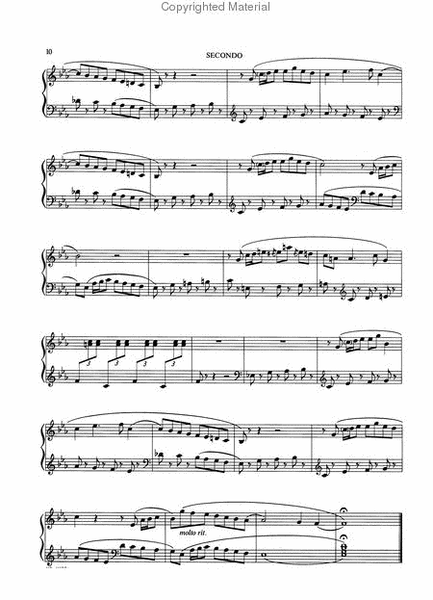Toot Suite
For Calliope or Organ, Four Hands
-
Ships in 1 to 2 weeks
Details
Description
SKU: PR.410411990
For Calliope or Organ, Four Hands. Composed by PDQ Bach. Edited by Peter Schickele. Sws. Classical. Score. With standard notation. S.212. 16 pages. Theodore Presser Company #410-41199. Published by Theodore Presser Company (PR.410411990).ISBN 9781598067279. UPC: 680160086061. 9x12 inches. Text: Professor Peter Schickele. Professor Peter Schickele.
Most musicological authorities state that Johann Sebastian Bach had twenty children; in so doing, they ally themselves with the relatives and descendants of the master, who have been conspiring for two centuries to eliminate every shred of evidence concerning the second most remarkable member of the family, P.D.Q. Bach (1807-1742)?. This last and least of the great J.S. Bach's offspring was slighted from the very beginning; he was not christened until he was five years old, and even then he was given, not a name, but merely three initials, his father claiming that he had used up all the names on his first twenty children. P.D.Q. spent his reclining years in Baden-Baden-Baden, a charming spa in southern Germany, and it was here that he composed the TOOT SUITE for Calliope Four Hands. Steam calliopes, of course, are still seen occasionally in circuses and parades, but in the 19th century, they were considerably more common, especially at resorts such as Baden-Baden-Baden, and P.D.Q. could not have been expected to resist writing for such a gross, ear-shattering instrument. Until 1972 the original manuscript eluded discovery, but one of its movements was published in an 1810 collection entitled ORIGINAL CALLIOPE WORKS THE WHOLE WORLD LOVES TO PLAY ON THEIR CALLIOPES, and thus it is that the FUGA VULGARIS has been recorded separately, on the Vanguard album P.D.Q. BACH ON THE AIR. On this recording a small indoor, or chamber, calliope was used, played by the great four-handed organist, Emmanuel Pedal; performances on the organ or harmonium seem entirely within the bounds of reasonable authenticity. With the discovery of the entire manuscript, including the PRELOUD and the O.K. CHORALE, we can now see the FUGA VULGARIS in its proper, myopic perspective, and the TOOT SUITE (Schickele No. 212) emerges as one of P.D.Q. Bach's most unusually representative works. Professor Peter Schickele.
Most musicological authorities state that Johann Sebastian Bach had twenty children; in so doing, they ally themselves with the relatives and descendants of the master, who have been conspiring for two centuries to eliminate every shred of evidence concerning the second most remarkable member of the family, P.D.Q. Bach (1807-1742)?. This last and least of the great J.S. Bach's offspring was slighted from the very beginning; he was not christened until he was five years old, and even then he was given, not a name, but merely three initials, his father claiming that he had used up all the names on his first twenty children.P.D.Q. spent his reclining years in Baden-Baden-Baden, a charming spa in southern Germany, and it was here that he composed the TOOT SUITE for Calliope Four Hands. Steam calliopes, of course, are still seen occasionally in circuses and parades, but in the 19th century, they were considerably more common, especially at resorts such as Baden-Baden-Baden, and P.D.Q. could not have been expected to resist writing for such a gross, ear-shattering instrument.Until 1972 the original manuscript eluded discovery, but one of its movements was published in an 1810 collection entitled ORIGINAL CALLIOPE WORKS THE WHOLE WORLD LOVES TO PLAY ON THEIR CALLIOPES, and thus it is that the FUGA VULGARIS has been recorded separately, on the Vanguard album P.D.Q. BACH ON THE AIR. On this recording a small indoor, or chamber, calliope was used, played by the great four-handed organist, Emmanuel Pedal; performances on the organ or harmonium seem entirely within the bounds of reasonable authenticity.With the discovery of the entire manuscript, including the PRELOUD and the O.K. CHORALE, we can now see the FUGA VULGARIS in its proper, myopic perspective, and the TOOT SUITE (Schickele No. 212) emerges as one of P.D.Q. Bach's most unusually representative works.Professor Peter Schickele.
Song List (3)
- I. Preloud
- II. O.K. Chorale
- III. Fuga Vulgaris




 Share
Share